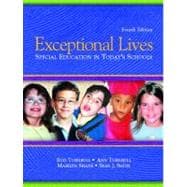
| Overview of Today's Special Education | p. 2 |
| Implementing IDEA's Principles | p. 40 |
| Special Education Today: Inclusion and Collaboration | p. 72 |
| Learning Disabilities | p. 104 |
| Emotional or Behavioral Disorders | p. 144 |
| Attention-Deficit/Hyperactivity Disorder | p. 180 |
| Giftedness | p. 222 |
| Mental Retardation | p. 260 |
| Severe and Multiple Disabilities | p. 300 |
| Autism | p. 336 |
| Other Health Impairments | p. 368 |
| Physical Disabilities | p. 404 |
| Traumatic Brain Injury | p. 438 |
| Communication Disorders | p. 480 |
| Hearing Loss | p. 516 |
| Blindness and Low Vision | p. 556 |
| Glossary | p. 597 |
| References | p. 605 |
| Name Index | p. 641 |
| Subject Index | p. 653 |
| Photo Credits | p. 673 |
| Table of Contents provided by Syndetics. All Rights Reserved. |
The New copy of this book will include any supplemental materials advertised. Please check the title of the book to determine if it should include any access cards, study guides, lab manuals, CDs, etc.
The Used, Rental and eBook copies of this book are not guaranteed to include any supplemental materials. Typically, only the book itself is included. This is true even if the title states it includes any access cards, study guides, lab manuals, CDs, etc.